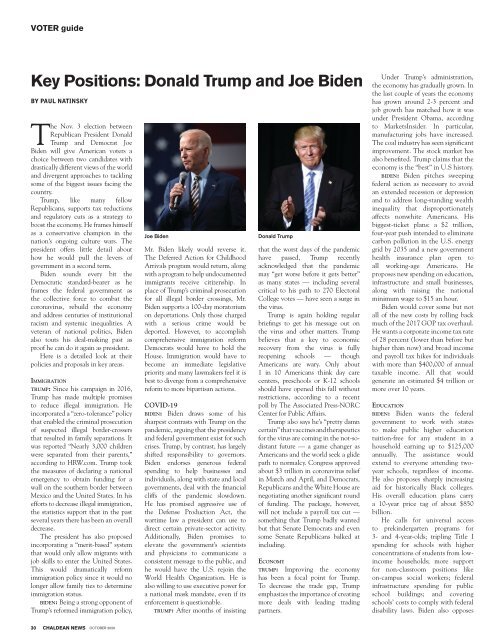OCTOBER 2020
Create successful ePaper yourself
Turn your PDF publications into a flip-book with our unique Google optimized e-Paper software.
VOTER guide<br />
Key Positions: Donald Trump and Joe Biden<br />
BY PAUL NATINSKY<br />
The Nov. 3 election between<br />
Republican President Donald<br />
Trump and Democrat Joe<br />
Biden will give American voters a<br />
choice between two candidates with<br />
drastically different views of the world<br />
and divergent approaches to tackling<br />
some of the biggest issues facing the<br />
country.<br />
Trump, like many fellow<br />
Republicans, supports tax reductions<br />
and regulatory cuts as a strategy to<br />
boost the economy. He frames himself<br />
as a conservative champion in the<br />
nation’s ongoing culture wars. The<br />
president offers little detail about<br />
how he would pull the levers of<br />
government in a second term.<br />
Biden sounds every bit the<br />
Democratic standard-bearer as he<br />
frames the federal government as<br />
the collective force to combat the<br />
coronavirus, rebuild the economy<br />
and address centuries of institutional<br />
racism and systemic inequalities. A<br />
veteran of national politics, Biden<br />
also touts his deal-making past as<br />
proof he can do it again as president.<br />
Here is a detailed look at their<br />
policies and proposals in key areas.<br />
Immigration<br />
trump: Since his campaign in 2016,<br />
Trump has made multiple promises<br />
to reduce illegal immigration. He<br />
incorporated a “zero-tolerance” policy<br />
that enabled the criminal prosecution<br />
of suspected illegal border-crossers<br />
that resulted in family separations. It<br />
was reported “Nearly 3,000 children<br />
were separated from their parents,”<br />
according to HRW.com. Trump took<br />
the measures of declaring a national<br />
emergency to obtain funding for a<br />
wall on the southern border between<br />
Mexico and the United States. In his<br />
efforts to decrease illegal immigration,<br />
the statistics support that in the past<br />
several years there has been an overall<br />
decrease.<br />
The president has also proposed<br />
incorporating a “merit-based” system<br />
that would only allow migrants with<br />
job skills to enter the United States.<br />
This would dramatically reform<br />
immigration policy since it would no<br />
longer allow family ties to determine<br />
immigration status.<br />
biden: Being a strong opponent of<br />
Trump’s reformed immigration policy,<br />
Joe Biden<br />
Mr. Biden likely would reverse it.<br />
The Deferred Action for Childhood<br />
Arrivals program would return, along<br />
with a program to help undocumented<br />
immigrants receive citizenship. In<br />
place of Trump’s criminal prosecution<br />
for all illegal border crossings, Mr.<br />
Biden supports a 100-day moratorium<br />
on deportations. Only those charged<br />
with a serious crime would be<br />
deported. However, to accomplish<br />
comprehensive immigration reform<br />
Democrats would have to hold the<br />
House. Immigration would have to<br />
become an immediate legislative<br />
priority and many lawmakers feel it is<br />
best to diverge from a comprehensive<br />
reform to more bipartisan actions.<br />
COVID-19<br />
biden: Biden draws some of his<br />
sharpest contrasts with Trump on the<br />
pandemic, arguing that the presidency<br />
and federal government exist for such<br />
crises. Trump, by contrast, has largely<br />
shifted responsibility to governors.<br />
Biden endorses generous federal<br />
spending to help businesses and<br />
individuals, along with state and local<br />
governments, deal with the financial<br />
cliffs of the pandemic slowdown.<br />
He has promised aggressive use of<br />
the Defense Production Act, the<br />
wartime law a president can use to<br />
direct certain private-sector activity.<br />
Additionally, Biden promises to<br />
elevate the government’s scientists<br />
and physicians to communicate a<br />
consistent message to the public, and<br />
he would have the U.S. rejoin the<br />
World Health Organization. He is<br />
also willing to use executive power for<br />
a national mask mandate, even if its<br />
enforcement is questionable.<br />
trump: After months of insisting<br />
Donald Trump<br />
that the worst days of the pandemic<br />
have passed, Trump recently<br />
acknowledged that the pandemic<br />
may “get worse before it gets better”<br />
as many states — including several<br />
critical to his path to 270 Electoral<br />
College votes — have seen a surge in<br />
the virus.<br />
Trump is again holding regular<br />
briefings to get his message out on<br />
the virus and other matters. Trump<br />
believes that a key to economic<br />
recovery from the virus is fully<br />
reopening schools — though<br />
Americans are wary. Only about<br />
1 in 10 Americans think day care<br />
centers, preschools or K-12 schools<br />
should have opened this fall without<br />
restrictions, according to a recent<br />
poll by The Associated Press-NORC<br />
Center for Public Affairs.<br />
Trump also says he’s “pretty damn<br />
certain” that vaccines and therapeutics<br />
for the virus are coming in the not-sodistant<br />
future — a game changer as<br />
Americans and the world seek a glide<br />
path to normalcy. Congress approved<br />
about $3 trillion in coronavirus relief<br />
in March and April, and Democrats,<br />
Republicans and the White House are<br />
negotiating another significant round<br />
of funding. The package, however,<br />
will not include a payroll tax cut —<br />
something that Trump badly wanted<br />
but that Senate Democrats and even<br />
some Senate Republicans balked at<br />
including.<br />
Economy<br />
trump: Improving the economy<br />
has been a focal point for Trump.<br />
To decrease the trade gap, Trump<br />
emphasizes the importance of creating<br />
more deals with leading trading<br />
partners.<br />
Under Trump’s administration,<br />
the economy has gradually grown. In<br />
the last couple of years the economy<br />
has grown around 2-3 percent and<br />
job growth has matched how it was<br />
under President Obama, according<br />
to MarketsInsider. In particular,<br />
manufacturing jobs have increased.<br />
The coal industry has seen significant<br />
improvement. The stock market has<br />
also benefited. Trump claims that the<br />
economy is the “best” in U.S history.<br />
biden: Biden pitches sweeping<br />
federal action as necessary to avoid<br />
an extended recession or depression<br />
and to address long-standing wealth<br />
inequality that disproportionately<br />
affects nonwhite Americans. His<br />
biggest-ticket plans: a $2 trillion,<br />
four-year push intended to eliminate<br />
carbon pollution in the U.S. energy<br />
grid by 2035 and a new government<br />
health insurance plan open to<br />
all working-age Americans. He<br />
proposes new spending on education,<br />
infrastructure and small businesses,<br />
along with raising the national<br />
minimum wage to $15 an hour.<br />
Biden would cover some but not<br />
all of the new costs by rolling back<br />
much of the 2017 GOP tax overhaul.<br />
He wants a corporate income tax rate<br />
of 28 percent (lower than before but<br />
higher than now) and broad income<br />
and payroll tax hikes for individuals<br />
with more than $400,000 of annual<br />
taxable income. All that would<br />
generate an estimated $4 trillion or<br />
more over 10 years.<br />
Education<br />
biden: Biden wants the federal<br />
government to work with states<br />
to make public higher education<br />
tuition-free for any student in a<br />
household earning up to $125,000<br />
annually. The assistance would<br />
extend to everyone attending twoyear<br />
schools, regardless of income.<br />
He also proposes sharply increasing<br />
aid for historically Black colleges.<br />
His overall education plans carry<br />
a 10-year price tag of about $850<br />
billion.<br />
He calls for universal access<br />
to prekindergarten programs for<br />
3- and 4-year-olds; tripling Title I<br />
spending for schools with higher<br />
concentrations of students from lowincome<br />
households; more support<br />
for non-classroom positions like<br />
on-campus social workers; federal<br />
infrastructure spending for public<br />
school buildings; and covering<br />
schools’ costs to comply with federal<br />
disability laws. Biden also opposes<br />
30 CHALDEAN NEWS <strong>OCTOBER</strong> <strong>2020</strong>

















